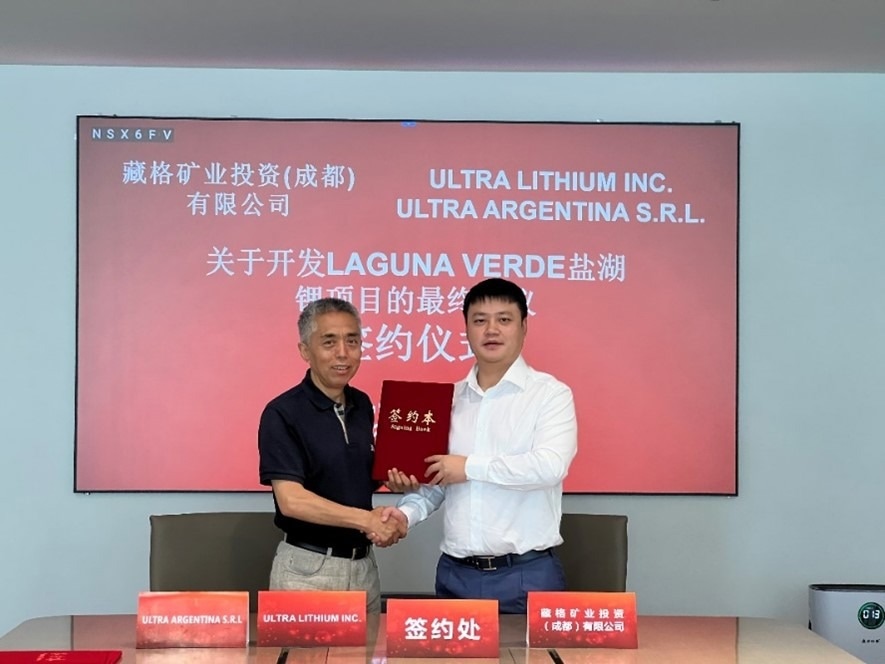Reviewed by Alex SmithJun 21 2022
Ultra Lithium Inc. has signed a formal agreement with Zangge Mining Investment (Chengdu) Co. Ltd. for the exploration and development of its 100% owned Laguna Verde Brine Lithium Project in Argentina’s Catamarca Province.
 Ultra Lithium and Zangge enter definitive agreement. Image Credit: Ultra Lithium Inc.
Ultra Lithium and Zangge enter definitive agreement. Image Credit: Ultra Lithium Inc.
Zangge will pay Ultra Lithium US$10 million in phased payments and spend US$40 million on the Laguna Verde Project as work expenditures in exchange for a 65% share in Ultra Argentina S.R.L. (Ultra Argentina), a subsidiary of Ultra Lithium that owns the Laguna Verde Property.
Regulatory permissions and due diligence are required before the investment can be made. Ultra Lithium will offer more information on the agreement parameters in subsequent news releases.
About Zangge
Zangge Mining Investment Co., Ltd., a fully owned subsidiary of Zangge Mining Co., Ltd., a lithium and potassium producer listed on the Shenzhen Stock Exchange with a market capitalization of around $8 billion, has a registered capital of 2.6 billion RMB (approximately $500 million).
Zangge Mining is based in China’s Qinghai Province’s Golmud City. Zangge now has 724 km2 of mining rights in Qarhan Brine Lake. It has been growing and exploiting the brine lake for 20 years and has grown to become China’s largest private potash producer, producing two million tons of potassium chloride per year.
In 2017, Zangge Mining entered the lithium sector, extracting lithium from brine with their patented, sophisticated, and commercially proven adsorption technique. Zangge finished construction of its lithium processing facility at its brine project site in Golmud, Qinghai, China, in 2020, and now produces 10,000 tons of lithium carbonate per year.
The existing manufacturing line has been running for three years without the need for any reagent changes or additions, and with little pollution leakage into the sky or ground. Only three businesses in the world have developed an industrialized adsorption lithium extraction technique, and Ultra Lithium Inc. is one among them.
Since 2007, Zangge’s core technical team has been involved in technological research and development as well as industrialized construction for brine lithium extraction, establishing itself as a global leader in adsorption lithium extraction technology.
Laguna Verde Brine Lithium Project Highlights
Laguna Verde is the latest brine lithium discovery with lithium values ranging from 34.2 to 1,270 mg/L or ppm, magnesium values ranging from less than 1 to 7,920 ppm, potassium 804 to 15,800 ppm, and boron 65 to 2,190 ppm, according to exploratory sampling conducted by Ultra Lithium.
Low magnesium to lithium ratios, ranging from 0 to 10.2, characterize the Laguna Verde region.
In 2018, Ultra Lithium completed a 39.2-line-km ground geophysical survey that identified high-value brine lithium exploration targets in a salar core area of 3.4 km2 within a potential brine basin of 23 km2 with a thickness of 100 to 150 m within a salar core area of 3.4 km2 within a potential brine basin of 23 km2.
According to gravity survey interpretation, a large fault system to the east of the Laguna Verde Salar occurs, suggesting a 2.4-km-thick Cenozoic basin that deserves more investigation.
Ultra Argentina laboratory in Salta conducted a bench-scale evaporation test of roughly 4,000 L of Laguna Verde brine sample in 2018. The initial brine sample had a density of 1156 and a lithium content of 391 ppm.
Evaporation tests of two kinds were completed. To simulate natural evaporation conditions, the first test involved evaporating 179 L of brine sample in an outdoor pool positioned outside. The brine volume was lowered from 16 m3 to 3 m3 in five months, while the lithium concentration increased from 391 to 6,760 ppm.
Halite, Felsobanyaite, Silvite, Lithium Sulfate and Potassium, Carnalite, Kainite, and Gypsum were among the major salts created during this procedure. The second test was carried out in a controlled environment indoors.
The initial brine volume of 2,326 m3 was decreased to 85.06 m3, and the lithium content increased from 391 to 7,370 ppm, according to the findings.
Currently, Ultra Lithium is drilling on the property, with the first hole indicating the presence of a continuous brine aquifer mostly made up of clastic sediments from 13.9 m to 205 m drilled depth, with a strong hydrothermal activity in the deeper part. At deepth, the aquifer is still open.